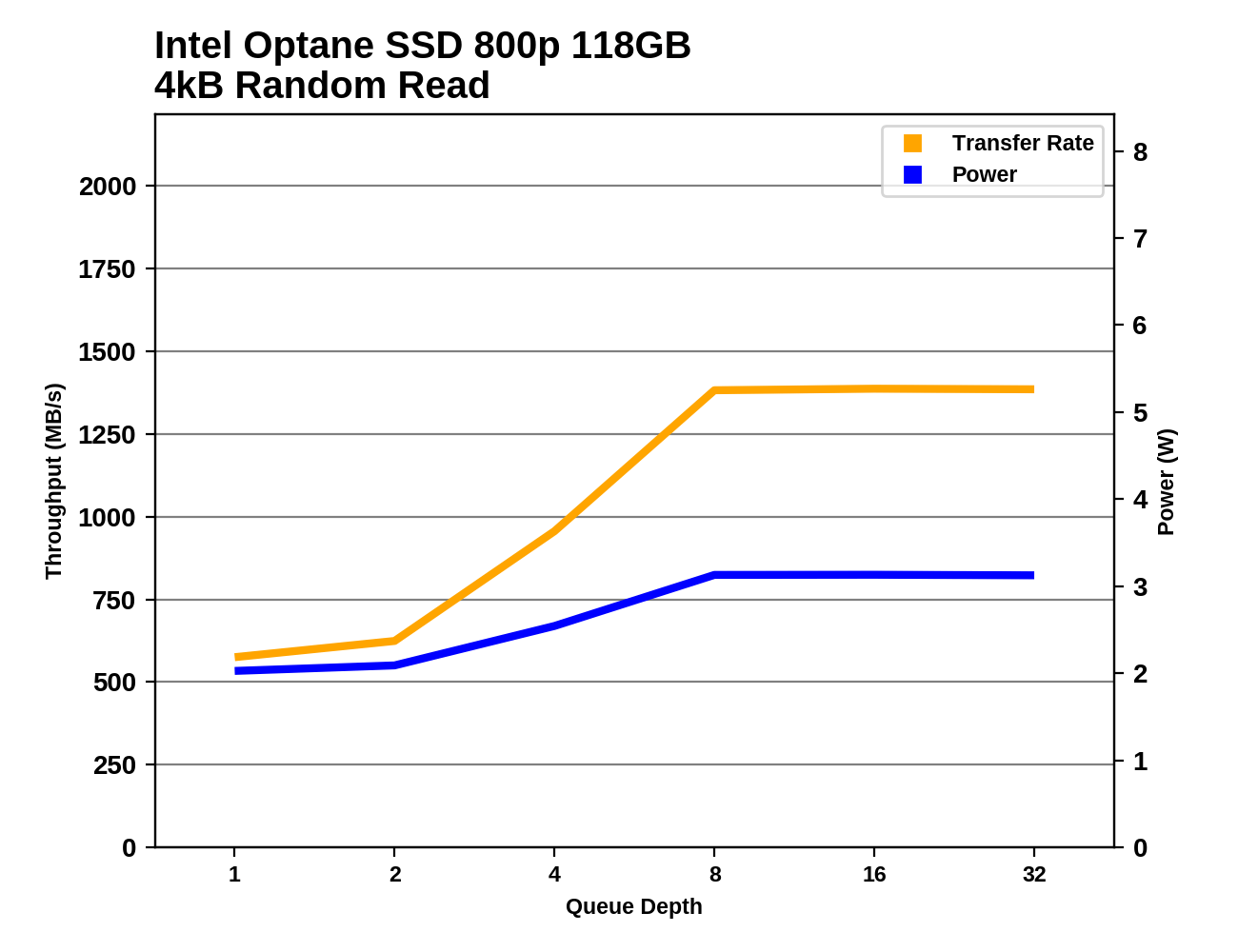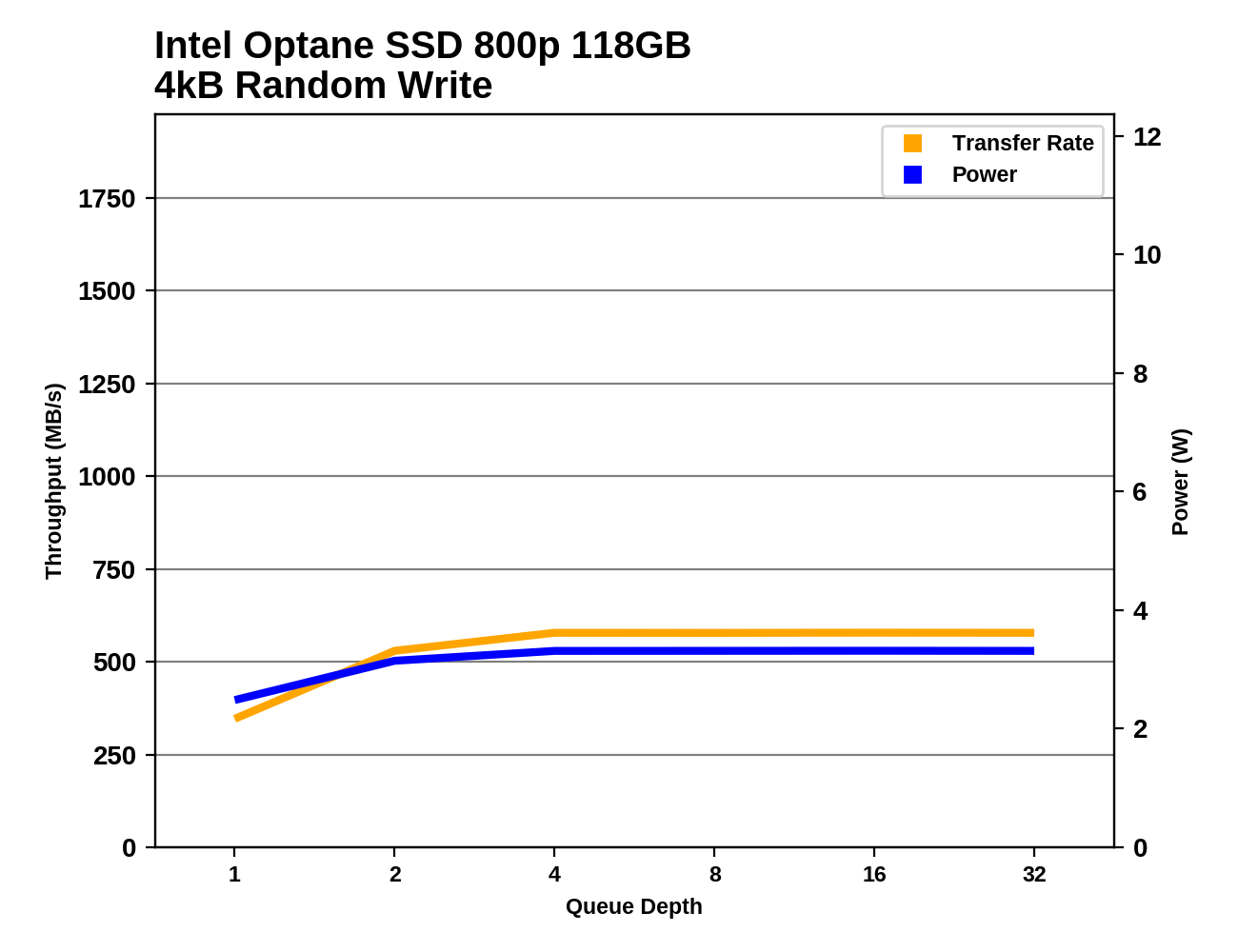The Intel Optane SSD 800p (58GB & 118GB) Review: Almost The Right Size
by Billy Tallis on March 8, 2018 5:15 PM ESTRandom Read Performance
Our first test of random read performance uses very short bursts of operations issued one at a time with no queuing. The drives are given enough idle time between bursts to yield an overall duty cycle of 20%, so thermal throttling is impossible. Each burst consists of a total of 32MB of 4kB random reads, from a 16GB span of the disk. The total data read is 1GB.

Like the Optane Memory M.2, the Optane SSD 800p has extremely high random read performance even at QD1. The M.2 drives even have a substantial lead over the much larger and more power-hungry 900p and its enterprise counterpart P4800X. Even the best flash-based SSDs are almost an order of magnitude slower.
Our sustained random read performance is similar to the random read test from our 2015 test suite: queue depths from 1 to 32 are tested, and the average performance and power efficiency across QD1, QD2 and QD4 are reported as the primary scores. Each queue depth is tested for one minute or 32GB of data transferred, whichever is shorter. After each queue depth is tested, the drive is given up to one minute to cool off so that the higher queue depths are unlikely to be affected by accumulated heat build-up. The individual read operations are again 4kB, and cover a 64GB span of the drive.

The Optane SSDs continue to dominate on the longer random read test, though the addition of higher queue depths allows the 900p to pull ahead of the 800p.

With extremely high performance but lacking the high power draw of the enterprise-class 900p, the Optane SSD 800p is by far the most power efficient at performing random reads.
 |
|||||||||
The Optane SSD 800p starts out in the lead at QD1, but its performance is overtaken by the 900p at all higher queue depths. The flash-based SSDs have power consumption that is comparable to the 800p, but even at QD32 Samsung's 960 PRO hasn't caught up to the 800p's random read performance.
Random Write Performance
Our test of random write burst performance is structured similarly to the random read burst test, but each burst is only 4MB and the total test length is 128MB. The 4kB random write operations are distributed over a 16GB span of the drive, and the operations are issued one at a time with no queuing.

Flash-based SSDs can cache and combine write operations, so they are able to offer random write performance close to that of the Optane SSDs, which do not perform any significant caching. Where the 32GB Optane Memory offered relatively poor burst random write performance, the 800p is at least as fast as the best flash-based SSDs.
As with the sustained random read test, our sustained 4kB random write test runs for up to one minute or 32GB per queue depth, covering a 64GB span of the drive and giving the drive up to 1 minute of idle time between queue depths to allow for write caches to be flushed and for the drive to cool down.

When higher queue depths come into play, the write caching ability of Samsung's high-end NVMe SSDs allows them to exceed the Optane SSD 800p's random write speed, though the 900p still holds on to the lead. The 800p's improvement over the Optane Memory is even more apparent with this longer test.

The power efficiency of the 800p during random writes is pretty good, though Samsung's top drives are better still. The Optane Memory lags behind on account of its poor performance, and the 900p ranks below that because it draws so much power in the process of delivering top performance.
 |
|||||||||
The Samsung 960 PRO and the Intel Optane SSD 900p show off at high queue depths thanks to the high channel counts of their controllers. The Optane SSD 800p doesn't have much room for performance to scale beyond QD2.










116 Comments
View All Comments
eddman - Monday, March 12, 2018 - link
90? It is stated as 20nm in that table up there.Nottheface - Monday, March 12, 2018 - link
I was told these are not related in a previous article's posts: https://www.anandtech.com/comments/12136/the-intel...Ewitte12 - Monday, April 30, 2018 - link
They had difficulty keeping the enterprise drives in stock.The 2X quote was for RAM. low queue depth obliterates NAND. Most other speeds are on par with NAND (with sustained a bit behind) but this is direct access to the storage. Most NAND drives have sophisticated RAM caching it can be writing way after the bar disappears off your screen.
The biggest issue with pricing. Optane has high early adopter fees (which come with a few extra bugs usually). Also anything under the 900p is kinda pointless. 3.0x2 and low capacities??? Not worth it.
Gothmoth - Friday, March 9, 2018 - link
intel hyped this like crazy and after reading the paper i was hyped too.but this seems like just another way for intel to push it´s stock market value with redicolous claims.
hescominsoon - Friday, March 9, 2018 - link
Semiaccurate had 3d x-point pegged from the beginning:https://www.semiaccurate.com/?s=point
Ashinjuka - Saturday, March 10, 2018 - link
Optanic.DanNeely - Thursday, March 8, 2018 - link
Could we see results from Optane as cache + budget SSD and Optane as cache + high end SSD?I'm not sure it'd be worthwhile with a fast SSD since it only beats them in a subset of benches, but it looks capable of giving a decent boost to budget flash. Cost effectiveness vs just buying better flash'd be the harder question.
iter - Thursday, March 8, 2018 - link
Cache only makes sense for a HDD. It would make no difference combining it with an SSD. Not in terms of real world application performance anyway.Spending on 118 gb of optane is pointless when you can get a decent 512 gb ssd for the same money. Over 200% higher the capacity at 99% of the performance. It is a no brainer. Intel will have to resort to bribing OEMs once again if they are to score any design wins.
patrickjp93 - Saturday, March 10, 2018 - link
Uh, think again on big data where the indices for the databases you're running are way too big to fit in memory. AWS is just one cloud provider making extensive use of Optane, especially in DynamoDB, RDS, Memcached, and Lambda where multi-tenant container environments definitely benefit in rapid spinup thanks to the much lower latency 3DXP.Billy Tallis - Thursday, March 8, 2018 - link
All of our usual SSD tests are for the drive acting as a secondary drive, but Intel's Optane-specific cache software only supports the boot volume, so it's rather awkward to test.